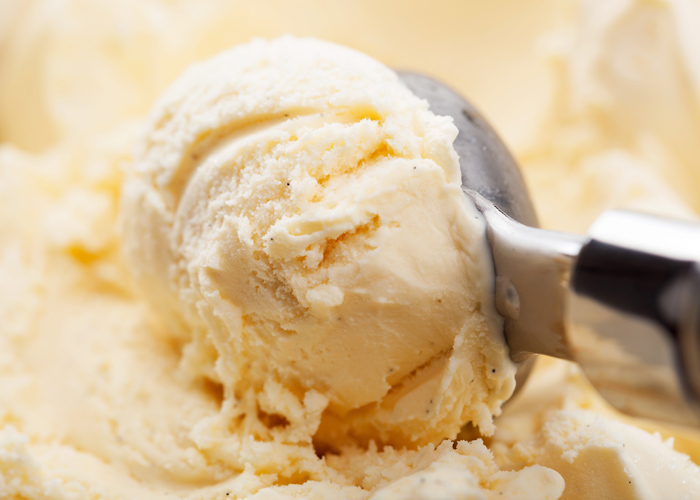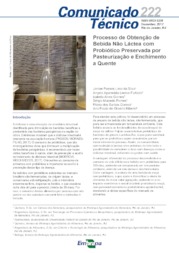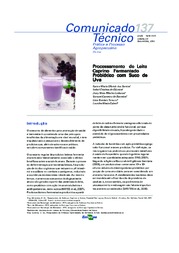Researchers develop probiotic goat milk ice cream
Researchers develop probiotic goat milk ice cream
The development of a diet, goat milk-based ice cream containing probiotics and prebiotics can contribute to extend the offer of functional foods that have goat milk as the main ingredient. The researcher from Embrapa Food Agroindustry Karina Olbrich highlights that the first tests showed that the ice cream formulation helped to reduce the blood glucose rate of healthy people and that it is also suitable for consumption by diabetic patients. That is likely due to the fact that type 2 diabetes has been associated with an imbalance of the intestinal microbiota (called dysbiosis), and probiotics and prebiotics can contribute to rebalance microorganism populations in the intestine.
The success of the first tests encouraged the researchers, who are now looking for partners from the private sector to expand the validation of results and develop upscaling for industrial production.
Besides goat milk, the ice cream contains cocoa powder, the prebiotic inulin, the probiotic bacteria Bifidobacterium lactis, and sucralose. The researcher explains that both probiotics and prebiotics work in the intestinal microbiota (flora). Probiotics are microorganisms that promote beneficial health effects if taken regularly and in adequate amounts. "Such microorganisms, usually lactobacilli and bifidobacteria, have to reach the intestinal colon (large intestine) alive, where they stay temporarily and perform beneficial activities for the organism", she explains.
Prebiotics, the researcher reports, are non-digestible compounds, usually food fibers that selectively stimulate the growing of beneficial bacteria, such as lactobacilli and bifidobacteria. "Prebiotics go through the stomach and the small intestine without being digested, and hence they arrive almost intact at the intestinal colon, where they are fermented by beneficial intestinal bacteria, promoting the growing and generation of substances that are beneficial to health", Olbrich clarifies.
The development of the ice cream was done in a partnership between the nutritionist and professor at the Federal Institute of Ceará (IFCE), Masu Portela, and the professor at the Federal University of Ceará (UFC), Sueli Rodrigues. The tests to develop formulas and most chemical, microbiological, and sensory analyses during the product storage, aiming to check stability, were performed at the Laboratory of Food Science and Technology (LCTA) at Embrapa Goats and Sheep.
The first clinical trials were performed at Embrapa Goats and Sheep and at three health posts in the city of Sobral, in Ceará state, both with diabetic and non-diabetic patients. "Healthy and diabetic individuals were submitted to tests to assess the glycemic response to the ice cream, that is, to verify if the ice cream consumption would reduce blood glucose, in comparison with glucose ingestion. The results were positive because blood glucose levels were lower after the consumption of the ice cream in both groups, even though the effect has only been statistically significant in the healthy group" details the Embrapa researcher.
According to her, the ice cream formula was successful because the product was able to maintain large populations of bifidobacteria when frozen, as it is required by law, and the digestion simulation tests pointed out that the bifidobacteria would resist the passage through the gastrointestinal tract well, which is important for the beneficial effects of probiotics in the intestine. "In addition, the sensory acceptance of the ice cream was high among diabetics, our target audience. The clinical trial also provided important results, confirming the low index and glucose load of the ice cream, and its low blood glucose impact after consumption, which favors glycemic control for diabetic people", she says.
The idea for the partnership to develop the study resulted from an agreement between Embrapa and IFCE - Sobral Campus , with students from the Food Technology course who were undergraduate interns at Embrapa Goats and Sheep. "When Masu started her doctorate degree at the Northeast Biotechnology Network (RENORBIO), she sought partnership with Embrapa, and the project to develop probiotic foods from goat milk was in progress" the scientist says.
"The ice cream is a product that favors the functioning of the gastrointestinal tract and has a low calory content compared to other ice creams in the market," Masu adds.
The researchers highlight that despite being promising, these are initial results and more tests will be necessary to validate the results.
Probiotics from goat milk
Karina says that she has been working on probiotics since 2007. According to her, the initial idea was to develop probiotic products from goat milk, seeking value aggregation and offer diversification of goat dairy products focusing on functional foods, that is, products that would offer health benefits beyond basic nutritional needs.
"Goat milk already stands out as a valuable food in the nutritional and health aspect due to its higher digestibility and lower allergenic potential in comparison with cow milk. It seemed relevant to aggregate new functionalities to goat milk, creating new products added with probiotic bacteria and expanding market opportunities" the scientist observes.
Why ice cream?
According to the researcher, depending on the ingredients used, the ice cream has been recognized as a food that might be part of a healthy diet, as it has a high nutritional value, and carries bioactive compounds.
The main technological challenge, according to Karina, is to ensure the feasibility of probiotic microorganisms in the food during storage and until the time of consumption. Moreover, they must be able to survive during the digestion process of the food until it reaches the intestine, where its action occurs.
"A high concentration of living microorganisms in the product on the shelf and after its digestion is a requirement of both Brazilian and international law. In the case of ice creams, steps such as aeration might affect the survival of probiotic bacteria because many of them tolerate little or do not tolerate contact with oxygen. Even the freezing process might damage the bacterial cells, if it is not adequate", she explains.
According to her, adjustments in the processing steps and the selection of a probiotic culture capable of resisting such challenges were important to obtain the ice cream.
Photo: iStock
Perspectives
Other goat-milk based probiotic products have already been developed by Embrapa using different commercial crops: cream cheese, semi-cured cheese, petit-suisse with passion fruit, yellow mombin ice cream, and fermented milk with grape juice enriched with polyphenols and grape peel fibers.
According to the researcher, the work with probiotics continues, mainly with native Brazilian bacteria that have been isolated from milk and goat dairy products that demonstrated probiotics properties in in-vitro and in-vivo tests. "New products with native bacteria are being developed in a project by Embrapa Food Technology including vegetable products such as cereal-based smoothies and drinks", she concludes.
Kadijah Suleiman (MTb 22.729/RJ)
Embrapa Food Technology
Press inquiries
agroindustria-de-alimentos.imprensa@embrapa.br
Phone number: +55 21 3622-9673
Translation (English): Luís Filipe Escobar, supervised by Mariana Medeiros
General Secretariat
Further information on the topic
Citizen Attention Service (SAC)
www.embrapa.br/contact-us/sac/



